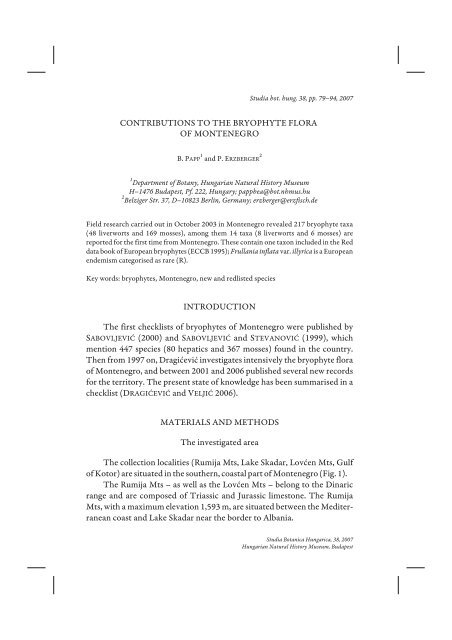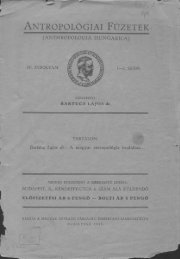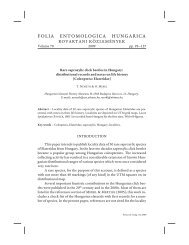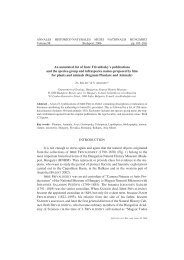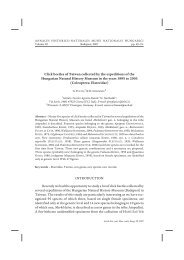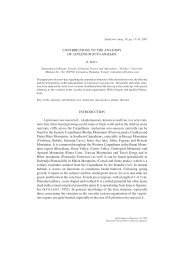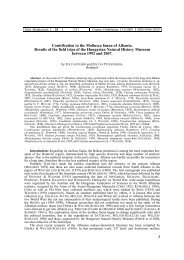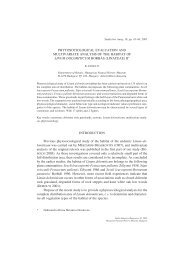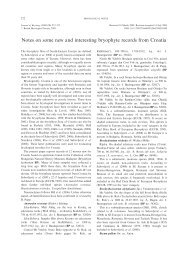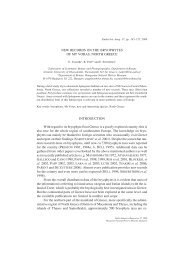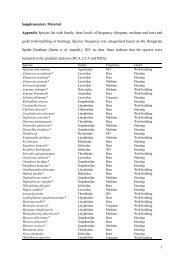CONTRIBUTIONS TO THE BRYOPHYTE FLORA OF ...
CONTRIBUTIONS TO THE BRYOPHYTE FLORA OF ...
CONTRIBUTIONS TO THE BRYOPHYTE FLORA OF ...
You also want an ePaper? Increase the reach of your titles
YUMPU automatically turns print PDFs into web optimized ePapers that Google loves.
Studia bot. hung. 38, pp. 79–94, 2007<br />
<strong>CONTRIBUTIONS</strong> <strong>TO</strong> <strong>THE</strong> <strong>BRYOPHYTE</strong> <strong>FLORA</strong><br />
<strong>OF</strong> MONTENEGRO<br />
B. PAPP 1 and P. ERZBERGER 2<br />
1 Department of Botany, Hungarian Natural History Museum<br />
H–1476 Budapest, Pf. 222, Hungary; pappbea@bot.nhmus.hu<br />
2 Belziger Str. 37, D–10823 Berlin, Germany; erzberger@erzfisch.de<br />
Field research carried out in October 2003 in Montenegro revealed 217 bryophyte taxa<br />
(48 liverworts and 169 mosses), among them 14 taxa (8 liverworts and 6 mosses) are<br />
reported for the first time from Montenegro. These contain one taxon included in the Red<br />
data book of European bryophytes (ECCB 1995); Frullania inflata var. illyrica is a European<br />
endemism categorised as rare (R).<br />
Key words: bryophytes, Montenegro, new and redlisted species<br />
INTRODUCTION<br />
The first checklists of bryophytes of Montenegro were published by<br />
SABOVLJEVIÆ (2000) and SABOVLJEVIÆ and STEVANOVIÆ (1999), which<br />
mention 447 species (80 hepatics and 367 mosses) found in the country.<br />
Then from 1997 on, Dragiæeviæ investigates intensively the bryophyte flora<br />
of Montenegro, and between 2001 and 2006 published several new records<br />
for the territory. The present state of knowledge has been summarised in a<br />
checklist (DRAGIÆEVIÆ and VELJIÆ 2006).<br />
MATERIALS AND METHODS<br />
The investigated area<br />
The collection localities (Rumija Mts, Lake Skadar, Lovæen Mts, Gulf<br />
of Kotor) are situated in the southern, coastal part of Montenegro (Fig. 1).<br />
The Rumija Mts – as well as the Lovæen Mts – belong to the Dinaric<br />
range and are composed of Triassic and Jurassic limestone. The Rumija<br />
Mts, with a maximum elevation 1,593 m, are situated between the Mediterranean<br />
coast and Lake Skadar near the border to Albania.<br />
Studia Botanica Hungarica, 38, 2007<br />
Hungarian Natural History Museum, Budapest
80 PAPP, B. and ERZBERGER, P.<br />
Lake Skadar (6 m above sea level) is shared by Montenegro and Albania,<br />
and is the largest lake in the Balkan Peninsula. Its full area can vary between<br />
370 and 530 km 2 . The lake is filled by the Moraèa River and drained<br />
into the Adriatic Sea by the 41-kilometre-long Buna/Bojana River, which<br />
forms the international border on the lower half of its length. The Montenegrian<br />
part of the lake and its surrounding area was declared a national<br />
park in 1983. It is one of the largest bird reserves in Europe, hosting 270<br />
bird species, among which are some of the last pelicans in Europe. In 1996 it<br />
was included in the Ramsar list of wetlands of international importance.<br />
Fig. 1. Locations of the investigated areas. (1 = Rumija Mts, 2 = Lake Skadar, 3 = Lovæen<br />
Mts, 4 = Gulf of Kotor) (BiH = Bosnia-Herzegovina, MO = Montenegro, SE = Serbia, Al =<br />
Albania)<br />
Studia bot. hung. 38, 2007
<strong>CONTRIBUTIONS</strong> <strong>TO</strong> <strong>THE</strong> <strong>BRYOPHYTE</strong> <strong>FLORA</strong> <strong>OF</strong> MONTENEGRO 81<br />
The Lovæen Mts rise from the borders of the Adriatic basin closing the<br />
long and twisting bays of Boka Kotorska. They are protected as a national<br />
park, covering 64 km 2 with an altitude range of 985 m to 1,749 m. In these<br />
mountain ranges, Mediterranean climate meets the moderately continental<br />
climate of the mountain belt. The carboniferous rocks of the Lovæen Mts<br />
appear in many special karst formations.<br />
The Gulf of Kotor, sometimes called Europe’s southernmost fjord, is<br />
in fact a submerged river canyon of the disintegrated Bokelj River, which<br />
used to run from the high mountain plateaus of Mt Orjen. The gulf is composed<br />
of several smaller broad gulfs, united by narrower channels, forming<br />
one of the finest natural harbours in Europe. The gulf inlet formerly was a<br />
river system, then very intensive tectonics and karstification processes led<br />
to the disintegration of this river. The length of the gulf is 28 km and its water<br />
surface is 87 km 2 . The Gulf of Kotor lies within the Mediterranean climate<br />
belt: while summers are hot and sunny, the autumn, winter and spring<br />
are the rainy seasons. A peculiarity of the littoral Dinarids is the precipitation<br />
regime: at the Gulf of Kotor, Mt Orjen receives Europe’s most heavy<br />
rainfall (4–5,000 mm per year). Just as the monsoon rain in other parts of<br />
the world is seasonally distributed, in November thunderstorms sometimes<br />
pour 2,000 l/m 2 of water in several days, while August is frequently completely<br />
dry, leading to forest fires. Strong, cold downslope winds of the<br />
Bora type arrive in winter. Gusts reach 250 km/h and can lead to a significant<br />
fall of temperatures in few hours with freezing temperatures that cause<br />
damage in most Mediterranean agricultural fields (e.g. orchards). The<br />
coastal area of the Gulf of Kotor is on the UNESCO List of Cultural and<br />
Natural Heritage.<br />
METHODS<br />
The collecting trip was made in October 2003. All main habitat types<br />
such as forests, grasslands, stream valleys were visited, and bryophytes were<br />
collected from different substrates (soil, exposed and shady rocks, tree<br />
barks and decaying wood).<br />
The specimens are deposited in the Hungarian Natural History Museum,<br />
Budapest (BP) and in the Botanical Museum, Berlin Dahlem (B).<br />
Studia bot. hung. 38, 2007
82 PAPP, B. and ERZBERGER, P.<br />
Nomenclature of the species follows GROLLE and LONG (2000) and HILL<br />
et al. (2006). New floristical results for the country were analysed using the<br />
new bryophyte checklist of Montenegro (DRAGIÆEVIÆ and VELJIÆ 2006).<br />
Site details<br />
1. At the border of Bosnia-Herzegovina and Montenegro at Hum, at river Tara, 450 m,<br />
43° 20’ 53.9” N, 18° 50’ 40.7” E, 07.10.2003.<br />
2. Montenegro, between Nikšiè and Podgorica, 1–2 km before the road to Zagorak, 275<br />
m, 42° 37’ 50.9” N, 19° 00’ 34.1” E, 07.10.2003.<br />
3. Montenegro, Rumija Mts, at Skadarsko jezero, at Vuèedabici village near Virpazar,<br />
458 m, 42° 07’ 40.1” N, 19° 13’ 28.7” E, 08.10.2003.<br />
4. Montenegro, Rumija Mts, at Skadarsko jezero, at the border of Albania near Ostros<br />
village, 450–480 m, 42° 03’ 52.2” N, 19° 22’ 31.2” E and 42° 03’ 21.7” N, 19° 20’ 28.4” E,<br />
08.10.2003.<br />
5. Montenegro, Rumija Mts, at Vladimir village near Šasko jezero lake, maquis, 28 m,<br />
41° 59’ 12.4” N, 19° 19’ 29.4” E, 08.10.2003.<br />
6. Montenegro, Rumija Mts, near Limljani village, at a stream, 557, 42° 10’ 14.4” N, 19°<br />
06’ 17.7” E, 09.10.2003.<br />
7. Montenegro, Rumija Mts, at the mountain pass along the road from Virpazar to Bar,<br />
around the ruins of a castle, 930 m, 42° 09’ 27.8” N, 19° 06’ 37.3” E, 09.10.2003.<br />
8. Montenegro, Stari Bar town, 10 m, 42° 05’ 37.9” N, 19° 08’ 05.8” E, 09.10.2003.<br />
9. Montenegro, at the northwestern part of Skadarsko jezero, near Mihaljeviæi village,<br />
110–135 m, 42° 18’ 13.6” N, 19° 02’ 56.6” E and 42° 19’ 05.9” N, 19° 02’ 59.4” E,<br />
10.10.2003.<br />
10. Montenegro, at the northwestern part of Skadarsko jezero, at Rijeka Crnojeviæa village,<br />
10 m, 42° 21’ 10.1” N, 19° 02’ 07.9” E, 10.10.2003.<br />
11. Montenegro, Lovæen Mts, near Njeguši village, along the road to the Mausoleum of<br />
Njegoš, Fagetum, 1,030 m, 42° 25’ 18.2” N, 18° 48’ 20.8” E, 11.10.2003.<br />
12. Montenegro, Lovæen Mts, along the road from Njeguši village to the Mausoleum of<br />
Njegoš, 1,100 m, 42° 24’ 53.3” N, 18° 48’ 43.5” E, 11.10.2003.<br />
13. Montenegro, Lovæen Mts, along the road from Njeguši village to the Mausoleum of<br />
Njegoš, at a stream, 1,300 m, 42° 22’ 50.8” N, 18° 49’ 37.0” E, 11.10.2003.<br />
14. Montenegro, Lovæen Mts, near Dolovi village, 1,255 m, 42° 22’ 17.5” N, 18° 49’ 24.1”<br />
E, 11.10.2003.<br />
15. Lovæen Mts, along the road from Njeguši village to Kotor, 350–370 m, 42° 23’ 57.6”<br />
N, 18° 46’ 12.5” E and 42° 23’ 50.1” N, 18° 45’ 59.6” E, 12–13.10.2003.<br />
16. Montenegro, on the peninsula west of Kotor, near Trojica fortress, maquis at a southwest<br />
facing slope, 290 m, 42° 24’ 23.5” N, 18° 45’ 22.8” E, 12.10.2003.<br />
17. Montenegro, Kotor, town walls and fortress, 0–100 m, 42° 25’ 33.3” N, 18° 46’ 23.6” E,<br />
13.10.2003.<br />
Studia bot. hung. 38, 2007
<strong>CONTRIBUTIONS</strong> <strong>TO</strong> <strong>THE</strong> <strong>BRYOPHYTE</strong> <strong>FLORA</strong> <strong>OF</strong> MONTENEGRO 83<br />
18. Montenegro, along the road from Kotor to Perast, at the pension Stari Mlini before<br />
Perast, stream, 0–10 m, 14.10.2003.<br />
19. Montenegro, along the road from Perast to Herceg-Novi, at Kostanjica village after<br />
Morinj, Quercetum and Castanetum on a north facing slope, 70–170 m, 42° 29’ 08.8”<br />
N, 18° 39’ 07.9” E and 42° 29’ 02.2” N, 18° 39’ 23.9” E, 14.10.2003.<br />
20. Montenegro, Lovæen Mts, southeast of Njeguši village, around a cave and dolina,<br />
900–1,138 m, 42° 25’ 36.2” N, 18° 49’ 53.0” E and 42° 25’ 09.9” N, 18° 51’ 02.7” E, leg.<br />
Barina, Z., Pifkó, D., 12.10.2003.<br />
RESULTS<br />
The full list of our records of bryophytes contains 217 taxa (48 liverworts<br />
and 169 mosses), including 14 (8 liverworts and 6 mosses), which are<br />
reported for the first time in Montenegro. These are the following.<br />
Hepaticae<br />
Barbilophozia barbata (Schreb.) Loeske is a boreal, montane species<br />
(DÜLL 1983). It is known from all other SE European countries except the<br />
European part of Turkey (SABOVLJEVIÆ and NATCHEVA 2006).<br />
Cephaloziella divaricata (Sm.) Schiffn. is a species characteristic of the<br />
temperate zone of Europe (DÜLL 1983). It is recorded in all other SE European<br />
countries except the European part of Turkey (SABOVLJEVIÆ and<br />
NATCHEVA 2006).<br />
Fossombronia pusilla (L.) Nees is a Mediterranean, sub-Atlantic element<br />
(DÜLL 1983). In SE Europe it is reported from many countries, i.e.<br />
Bulgaria, Croatia, Greece, Macedonia, Romania, Serbia, Slovenia, Turkey<br />
(SABOVLJEVIÆ and NATCHEVA 2006).<br />
Frullania inflata Gottsche var. illyrica (Grolle) R. M. Schust. is a relict<br />
Mediterranean-montane species according to DÜLL (1983), while var. inflata<br />
is a relict sub-Mediterranean-montane hepatic. Frullania inflata var.<br />
illyrica was known as an Albanian endemic (BISANG et al. 1988) differing<br />
from the type variety by fewer and larger oil bodies, but this character was<br />
considered by GROLLE and LONG (2000) to be variable, and therefore var.<br />
illyrica was synonymised with var. inflata. Our material shows the characteristics<br />
of var. illyrica, and we prefer keeping this name pending further<br />
Studia bot. hung. 38, 2007
84 PAPP, B. and ERZBERGER, P.<br />
research. In Europe, F. inflata is known from 7 countries (Albania, Austria,<br />
Czech Republic, Hungary, Italy, Slovenia). It was rated vulnerable by the<br />
Red data book of European bryophytes (ECCB 1995), but is presently considered<br />
near threatened only, since about 15 recent localities are known<br />
from Austria (VÁÒA 2001), and a new locality has also been detected in<br />
Hungary (PAPP and ERZBERGER 2006). The present records from Montenegro<br />
are therefore very significant on a European scale.<br />
Lophocolea minor Nees is a species of the temperate zone of Europe<br />
(DÜLL 1983). It was reported from all other SE European countries except<br />
the European part of Turkey (SABOVLJEVIÆ and NATCHEVA 2006).<br />
Riccia glauca L. is a sub-Mediterranean species (DÜLL 1983) known<br />
from almost all SE European countries except Macedonia and the European<br />
part of Turkey (SABOVLJEVIÆ and NATCHEVA 2006).<br />
Riccia macrocarpa Levier is a sub-Atlantic, Mediterranean element<br />
(DÜLL 1983). This species was reported in SE Europe only from Albania,<br />
Croatia and Greece (SABOVLJEVIÆ and NATCHEVA 2006).<br />
Riccia trabutiana Steph. is an Atlantic, Mediterranean element (DÜLL<br />
1983). This species was known in SE Europe only from Albania and Greece<br />
(SABOVLJEVIÆ and NATCHEVA 2006).<br />
Musci<br />
Grimmia dissimulata E. Maier was recently described (MAIER 2002).<br />
Its distribution is as follows: Africa: Morocco; Asia: Syria, Turkey; Europe:<br />
Austria, Belgium, Cyprus, France, Germany, Great Britain, Greece, Hungary,<br />
Italy, Spain, Switzerland (MAIER 2002, PORLEY 2004 and ERZBERGER<br />
and PAPP 2004).<br />
Schistidium brunnescens Limpr. subsp. griseum (Nees et Hornsch.) H.<br />
H. Blom is closely related to S. brunnescens subps. brunnescens, but apparently<br />
much rarer in parts of Central and Eastern Europe (BLOM 1996). It<br />
occurs from Southern Scandinavia to South Europe and Turkey. In SE Europe<br />
it has been collected in Croatia, Bosnia-Hercegovina, Bulgaria and<br />
Greece (BLOM 1996).<br />
Schistidium helveticum (Schkuhr) Deguchi has a Mediterranean distribution<br />
(South-Europe, North-Africa, West-Asia, BLOM 1996). In SE<br />
Studia bot. hung. 38, 2007
<strong>CONTRIBUTIONS</strong> <strong>TO</strong> <strong>THE</strong> <strong>BRYOPHYTE</strong> <strong>FLORA</strong> <strong>OF</strong> MONTENEGRO 85<br />
Europe it is known from Greece (DÜLL 1995) and Serbia (SABOVLJEVIÆ 2003).<br />
Scorpiurium deflexifolium (Solms) M. Fleisch. et Loeske is a Mediterranean<br />
element (DÜLL 1985). In SE Europe it is known from Bosnia-Herzegovina,<br />
Slovenia (DÜLL et al. 1999), Greece (DÜLL 1995) and Albania<br />
(COLACINO and SABOVLJEVIÆ 2006).<br />
Syntrichia handelii (Schiffn.) S. Agnew et Vondr. is an East Mediterranean,<br />
continental element (DÜLL 1984). In SE Europe it is recorded only in<br />
Greece (DÜLL 1995).<br />
Weissia longifolia Mitt. var. angustifolia (Baumgartner) Crundw. et<br />
Nyholm is an Atlantic, sub-Mediterranean taxon (DÜLL 1984). In SE Europe<br />
it is reported only from Croatia (DÜLL et al. 1999).<br />
List of the species collected<br />
Following the species name, the numbers of the localities and the substrates<br />
are given.<br />
Hepaticae<br />
Barbilophozia barbata (Schmidel ex Schreb.) Loeske – 11: limestone rocks<br />
Cephalozia bicuspidata (L.) Dumort. – 6: limestone rocks at the stream<br />
Cephaloziella baumgartneri Schiffn. – 6: limestone rocks at the stream<br />
Cephaloziella divaricata (Sm.) Schiffn. – 5, 16: on soil in maquis<br />
Cololejeunea calcarea (Lib.) Schiffn. – 20: shaded calcareous rocks<br />
Cololejeunea minutissima (Sm.) Schiffn. – 19: on the bark of Laurus nobilis (rev. Váòa)<br />
Cololejeunea rosettiana (C. Massal.) Schiffn. – 14, 19: shaded limestone rocks<br />
Conocephalum conicum (L.) Dumort. – 9: limestone rocks at the stream; 20: limestone<br />
rocks<br />
Fossombronia husnotii Corb. – 5: on soil in maquis<br />
Fossombronia pusilla (L.) Nees – 3: base-rich rock in Quercetum<br />
Frullania dilatata (L.) Dumort. – 3: on the bark of Carpinus and Quercus, 6: on tree bark;<br />
7: on the bark of Acer; 11: on the bark of Fagus; 15: on the bark of Cupressus; 16: on<br />
the bark of Quercus<br />
Frullania inflata Gottsche var. illyrica (Grolle) R. M. Schust. – 7, 15: limestone rocks<br />
(conf. Váòa)<br />
Leiocolea collaris (Nees) Schljakov – 1: limestone rocks at the stream; 12, 14: shaded limestone<br />
rocks (conf. Váòa)<br />
Leiocolea turbinata (Raddi) H. Buch – 6: limestone rocks at the stream (conf./det. Váòa)<br />
Studia bot. hung. 38, 2007
86 PAPP, B. and ERZBERGER, P.<br />
Lejeunea cavifolia (Ehrh.) Lindb. – 6: limestone rocks at the stream; 19: limestone rocks<br />
and on the bark of Quercus and of Laurus nobilis<br />
Lophocolea heterophylla (Schrad.) Dumort. – 19: limestone rocks<br />
Lophocolea minor Nees – 14: on soil among limestone rocks<br />
Lunularia cruciata (L.) Lindb. – 9, 10: limestone rocks at the stream; 19: soil among limestone<br />
rocks<br />
Mannia androgyna (L.) A. Evans – 15: on soil among limestone rocks<br />
Marchantia polymorpha L. subsp. polymorpha – 20: limestone rocks<br />
Marchantia polymorpha L. subsp. ruderalis Bisch. et Boisselier – 9: limestone rocks at the<br />
stream<br />
Metzgeria furcata (L.) Dumort. – 14: shaded calcareous rock; 16: on the bark of Quercus;<br />
on decaying wood; 19: on the bark of Quercus and of Laurus nobilis<br />
Pedinophyllum interruptum (Nees) Kaal. – 1: moist limestone rocks at the riverbank; 20:<br />
shaded limestone rocks<br />
Pellia endiviifolia (Dicks.) Dumort. – 6, 9: limestone rocks at the stream; 20: limestone<br />
rocks<br />
Plagiochasma rupestre (J. R. Forst. et G. Forst.) Steph. – 17: walls of the fortress<br />
Plagiochila porelloides (Torrey ex Nees) Lindenb. – 11, 12, 14: limestone rocks<br />
Porella cordaeana (Huebener) Mohr – 7, 11, 12, 14: limestone rocks<br />
Porella platyphylla (L.) Pfeiff. – 4, 7: shaded limestone rocks<br />
Preissia quadrata (Scop.) Nees – 6, 9: on calcareous soil; 12, 14: on soil among limestone<br />
rocks<br />
Radula complanata (L.) Dumort. – 1: limestone rocks at the stream; 3: on the bark of tree;<br />
6, 7: limestone rocks and on the bark of Acer; 11: on the bark of Fagus; 14, 19: limestone<br />
rocks; 16: on the bark of Quercus<br />
Reboulia hemisphaerica (L.) Raddi – 2, 3, 9, 10, 14, 15, 19: on soil among rocks; 5, 16: on<br />
soil in maquis; 8: walls of town fortification; 17: walls of the fortress<br />
Riccia ciliata Hoffm. – 5: on soil in maquis (det./conf. Sérgio)<br />
Riccia ciliifera Link ex Lindenb. – 14: on soil among limestone rocks (det. Sérgio)<br />
Riccia crozalsii Levier – 12, 14: on soil among limestone rocks (det. Sérgio)<br />
Riccia glauca L. – 14, 16: on soil in maquis (det./conf. Sérgio)<br />
Riccia macrocarpa Levier – 5, 16: on soil in maquis (det./conf. Sérgio)<br />
Riccia michelii Raddi – 12: on soil among limestone rocks (conf. Sérgio)<br />
Riccia papillosa Moris – 5: on soil in maquis (conf. Sérgio)<br />
Riccia sorocarpa Bisch. – 12, 16: on soil among limestone rocks (det./conf. Sérgio)<br />
Riccia trabutiana Steph. – 16: on soil in maquis (det. Sérgio)<br />
Scapania aequiloba (Schwägr.) Dumort. – 14: shaded limestone rocks (det. Váòa)<br />
Scapania aspera Bernet et M. Bernet – 3, 11, 12, 14: shaded limestone rocks (conf. Váòa)<br />
Scapania compacta (A. Roth) Dumort. – 19: on soil (det./conf.Váòa)<br />
Scapania nemorea (L.) Grolle – 3, 11, 12, 14, 20: limestone rocks<br />
Southbya nigrella (De Not.) Henriq. – 2, 9, 15, 16: on basic soil of perpendicular conglomerate<br />
rocks<br />
Studia bot. hung. 38, 2007
<strong>CONTRIBUTIONS</strong> <strong>TO</strong> <strong>THE</strong> <strong>BRYOPHYTE</strong> <strong>FLORA</strong> <strong>OF</strong> MONTENEGRO 87<br />
Southbya tophacea (Spruce) Spruce – 10: limestone rocks at the lake<br />
Targionia hypophylla L. – 10: limestone rocks at the stream; 12: on soil among limestone<br />
rocks<br />
Targionia lorbeeriana Müll. Frib. – 4: exposed conglomerate rocks; 8: walls of the fortress<br />
Musci<br />
Abietinella abietina (Hedw.) M. Fleisch. – 11, 12, 14: soil among limestone rocks<br />
Aloina aloides (Koch ex Schultz) Kindb. – 4: exposed conglomerate rocks<br />
Aloina ambigua (Bruch et Schimp.) Limpr. – 2: exposed conglomerate rocks<br />
Anomodon attenuatus (Hedw.) Huebener – 1: limestone rocks at the stream<br />
Anomodon viticulosus (Hedw.) Hook. et Taylor – 1: limestone rocks at the stream; 7, 14,<br />
19: limestone rocks<br />
Atrichum angustatum (Brid.) Bruch et Schimp. – 19: on soil<br />
Barbula convoluta Hedw. – 12, 15: on soil among limestone rocks<br />
Barbula unguiculata Hedw. – 2: exposed conglomerate rocks, 11: on soil among limestone<br />
rocks<br />
Bartramia stricta Brid. – 19: limestone rocks<br />
Brachytheciastrum velutinum (Hedw.) Ignatov et Huttunen – 6, 11, 19: limestone rocks<br />
Brachythecium glareosum (Bruch ex Spruce) Schimp. – 14: on soil among limestone rocks<br />
Brachythecium rivulare Schimp. – 6, 9, 13: limestone rocks at the stream<br />
Brachythecium rutabulum (Hedw.) Schimp. – 6, 9, 10: limestone rocks at the stream; 11,<br />
15, 19: limestone rocks; 11: on the bark of Fagus<br />
Bryoerythrophyllum recurvirostrum (Hedw.) P. C. Chen – 1: limestone rocks at the<br />
stream; 14: limestone rocks<br />
Bryum argenteum Hedw. – 11, 12: on soil near limestone rocks<br />
Bryum caespiticium Hedw. – 17: walls of the fortress<br />
Bryum capillare Hedw. – 4, 7, 10, 12, 14, 16, 20: limestone rocks and calcareous soil; 13:<br />
limestone rocks at the stream<br />
Bryum elegans Nees – 14: limestone rocks<br />
Bryum moravicum Podp. – 14: limestone rocks<br />
Bryum pseudotriquetrum (Hedw.) P. Gaertn. et al. – 6, 9, 10, 13: limestone rocks at the stream<br />
Bryum torquescens Bruch et Schimp. – 16: on soil in maquis<br />
Calliergonella cuspidata (Hedw.) Loeske – 10: limestone rocks at the lake; 15, 19: on soil<br />
Campyliadelphus chrysophyllus (Brid.) R. S. Chopra – 6, 10: limestone rocks at the<br />
stream; 11, 12, 14: limestone rocks<br />
Campylophyllum calcareum (Crundw. et Nyholm) Hedenäs – 11: limestone rocks<br />
Ceratodon purpureus (Hedw.) Brid. – 14: on soil among limestone rocks<br />
Cinclidotus aquaticus (Hedw.) Bruch et Schimp. – 9, 18: limestone rocks at the stream<br />
Cinclidotus fontinaloides (Hedw.) P. Beauv. – 1, 9, 10, 15, 18: limestone rocks at the streams;<br />
10: on the bark of Fraxinus at the stream and on concrete at the shore of the lake<br />
Studia bot. hung. 38, 2007
88 PAPP, B. and ERZBERGER, P.<br />
Cinclidotus riparius (Host ex Brid.) Arn. – 9: limestone rocks at the stream<br />
Cirriphyllum crassinervium (Taylor) Loeske et M. Fleisch. – 1: limestone rocks at the<br />
stream; 6, 15: limestone rocks at the stream; 7, 11, 14, 19: limestone rocks<br />
Cratoneuron filicinum (Hedw.) Spruce – 1, 6, 9, 10, 13, 15: limestone rocks at the stream;<br />
20: limestone rocks<br />
Crossidium squamiferum (Viv.) Jur. – 2, 4, 16: exposed conglomerate rocks<br />
Cryphaea heteromalla (Hedw.) D. Mohr – 10: on the bark of timber in the port<br />
Ctenidium molluscum (Hedw.) Mitt. – 1, 6, 10, 15: limestone rocks at the stream; 3, 5, 7,<br />
11, 12, 14, 19, 20: limestone rocks<br />
Dicranella howei Renauld et Cardot – 4: exposed conglomerate rocks; 11, 15, 19: on soil<br />
among limestone rocks<br />
Dicranella schreberiana (Hedw.) Dixon – 1: limestone rocks at the stream<br />
Dicranella varia (Hedw.) Schimp. – 1, 6: limestone rocks at the stream<br />
Dicranum scoparium Hedw. – 11, 14, 20: limestone rocks<br />
Didymodon acutus (Brid.) K. Saito – 4: exposed conglomerate rocks; 6: limestone rocks at<br />
the stream; 16: on soil in maquis<br />
Didymodon fallax (Hedw.) R. H. Zander – 1: limestone rocks at the stream<br />
Didymodon ferrugineus (Schimp. ex Besch.) M. O. Hill – 1: limestone rocks at the stream<br />
Didymodon insulanus (De Not.) M. O. Hill – 1, 9: limestone rocks at the stream<br />
Didymodon luridus Hornsch. – 2, 4, 16: exposed conglomerate rocks; 9, 10, 15: limestone<br />
rocks at the stream; 11, 19: limestone rocks<br />
Didymodon rigidulus Hedw. – 1: limestone rocks at the stream; 14: limestone rocks<br />
Didymodon sinuosus (Mitt.) Delogne – 10: limestone rocks at the stream<br />
Didymodon tophaceus (Brid.) Lisa – 6: limestone rocks at the stream<br />
Didymodon vinealis (Brid.) R. H. Zander – 1, 6, 9, 10: limestone rocks at the stream or<br />
lake, resp.; 11: shaded limestone rocks<br />
Diphyscium foliosum (Hedw.) D. Mohr – 19: on soil<br />
Distichium capillaceum (Hedw.) Bruch et Schimp. – 14, 20: limestone rocks<br />
Ditrichum flexicaule (Schwägr.) Hampe – 1: limestone rocks at the stream; 12, 14, 20:<br />
limestone rocks<br />
Ditrichum gracile (Mitt.) Kuntze – 12, 14, 20: limestone rocks<br />
Ditrichum pusillum (Hedw.) Hampe – 14: on soil among limestone rocks; 16: on soil in<br />
maquis<br />
Encalypta streptocarpa Hedw. – 1, 6: limestone rocks at the stream; 3, 7, 12, 14: limestone rocks<br />
Encalypta vulgaris Hedw. – 15: limestone rocks at the stream<br />
Entodon concinnus (De Not.) Paris – 6: limestone rocks at the stream; 14: limestone rocks<br />
Entosthodon pulchellus (H. Philib.) Brugués – 3: basic soil<br />
Eucladium verticillatum (With.) Bruch et Schimp. – 6, 9, 10, 15: limestone rocks at the<br />
stream; 17: walls of the fortress<br />
Eurhynchiastrum pulchellum (Hedw.) Ignatov et Huttunen – 14: limestone rocks<br />
Eurhynchium striatum (Hedw.) Schimp. – 15: limestone rocks at the stream; 19: soil<br />
among limestone rocks<br />
Studia bot. hung. 38, 2007
<strong>CONTRIBUTIONS</strong> <strong>TO</strong> <strong>THE</strong> <strong>BRYOPHYTE</strong> <strong>FLORA</strong> <strong>OF</strong> MONTENEGRO 89<br />
Fissidens bryoides Hedw. – 15: on soil among limestone rocks at the stream; 11, 19: on soil<br />
Fissidens crassipes Wilson ex Bruch et Schimp. subsp. crassipes – 17: limestone rocks at the<br />
stream<br />
Fissidens crassipes Wilson ex Bruch et Schimp. subsp. warnstorfii (M. Fleisch.)<br />
Brugg.-Nann. – 9: limestone rocks at the stream<br />
Fissidens dubius P. Beauv. – 1, 6, 10, 15: limestone rocks at the stream; 2: exposed conglomerate<br />
rocks; 3, 5, 7, 11, 12, 14, 19, 20: limestone rocks<br />
Fissidens taxifolius Hedw. – 5, 16: on soil in maquis; 12: on soil among limestone rocks; 6,<br />
15: on soil among limestone rocks at the stream<br />
Fissidens viridulus (Sw. ex anon.) Wahlenb. – 15: on soil among limestone rocks at the<br />
stream; 16: on soil in maquis<br />
Fontinalis hypnoides C. Hartm. – 9, 10: limestone rocks in the stream<br />
Grimmia dissimulata E. Maier – 3, 6, 7, 10: limestone rocks (conf./det. E. Maier)<br />
Grimmia orbicularis Bruch ex Wilson – 6, 10: limestone rocks (det. E. Maier)<br />
Grimmia pulvinata (Hedw.) Sm. – 4, 16: exposed conglomerate rocks; 6: limestone rocks<br />
at the stream; 7, 10, 12: limestone rocks<br />
Gymnostomum aeruginosum Sm. – 1, 6, 10, 15: limestone rocks at the stream; 14: limestone<br />
rocks<br />
Gymnostomum calcareum Nees et Hornsch. – 9, 10: 14: limestone rocks at the stream<br />
Gyroweisia tenuis (Hedw.) Schimp. – 2, 4, 16, 17, 18: exposed conglomerate rocks; 9: calcareous<br />
soil; 17: on moist walls of fortress; 18: on limestone rock in stream bed<br />
Habrodon perpusillus (De Not.) Lindb. – 3: on tree bark; 15: on the bark of Cupressus<br />
sempervirens; 16, 19: on the bark of Fraxinus and Quercus<br />
Homalothecium lutescens (Hedw.) H. Rob. – 3, 11, 12: soil among limestone rocks; 11, 14,<br />
15: on limestone rocks; 16: on soil in maquis<br />
Homalothecium philippeanum (Spruce) Schimp. – 12, 14: shaded limestone rock<br />
Homalothecium sericeum (Hedw.) Schimp. – 1, 15: limestone rocks at the stream; 2: exposed<br />
conglomerate rocks; 3, 5, 6, 7: limestone rocks; 3: on the bark of Carpinus and<br />
Quercus; 11: on the bark of Fagus; 16: on the bark of Quercus<br />
Hygrohypnum luridum (Hedw.) Jenn. – 1, 6, 13: limestone rocks at the stream<br />
Hylocomium splendens (Hedw.) Schimp. – 1: limestone rocks at the stream; 11, 12, 14:<br />
limestone rocks<br />
Hypnum cupressiforme Hedw. var. cupressiforme – 1: limestone rocks at the stream; 3, 5,<br />
16: on the bark of trees; 7: on the bark of Quercus; 6, 11, 19: on limestone rocks and<br />
on soil; 16: on soil in maquis<br />
Hypnum cupressiforme Hedw. var. lacunosum Brid. – 6: limestone rocks at the stream; 12,<br />
14: on soil among limestone rocks; 17: walls of the fortress<br />
Isopterygiopsis pulchella (Hedw.) Z. Iwats. – 20: limestone rocks<br />
Isothecium alopecuroides (Lam. ex Dubois) Isov. – 3, 11, 19: limestone rocks; 6: limestone<br />
rocks at the stream; 11: on the bark of Fagus<br />
Kindbergia praelonga (Hedw.) Ochyra – 12, 19: on limestone rocks and on soil<br />
Studia bot. hung. 38, 2007
90 PAPP, B. and ERZBERGER, P.<br />
Leptodon smithii (Hedw.) F. Weber et D. Mohr – 3: on the bark of Carpinus and Quercus;<br />
7: on the bark of Acer; 15: on the bark of Cupressus; 16, 19: on the bark of Quercus;6,<br />
19: limestone rocks<br />
Leucodon sciuroides (Hedw.) Schwägr. – 3, 6: on the bark of Carpinus and Quercus;7:on<br />
the bark of Acer; 10: on the bark of timber in the port; 16: on the bark of Quercus<br />
Mnium marginatum (Dicks.) P. Beauv. – 1: limestone rocks at the stream; 14, 20: limestone<br />
rocks<br />
Mnium stellare Hedw. – 1: limestone rocks at the stream; 11, 12, 14: limestone rocks<br />
Mnium thomsonii Schimp. – 1: limestone rocks at the stream<br />
Myurella julacea (Schwägr.) Schimp. – 1: limestone rocks at the stream; 14: limestone rocks<br />
Neckera besseri (Lobarz.) Jur. – 7: limestone rocks<br />
Neckera complanata (Hedw.) Huebener – 3: on the bark of tree; 5, 6, 7, 9, 14, 19: limestone<br />
rocks; 11: on the bark of Fagus; 19: on the bark of Quercus<br />
Neckera crispa Hedw. – 6, 16: limestone rocks at the stream; 7, 11, 14, 19, 20: shaded limestone<br />
rocks; 11: on the bark of Fagus<br />
Neckera menziesii Drumm. – 14: shaded limestone rocks<br />
Orthothecium intricatum (Hartm.) Schimp. – 14: shaded limestone rocks<br />
Orthotrichum affine Schrad. ex Brid. – 7 on the bark of Quercus; 11: on the bark of Fagus<br />
Orthotrichum anomalum Hedw. – 4, 5, 7, 11, 12: limestone rocks<br />
Orthotrichum cupulatum Hoffm. ex Brid. – 5, 7, 9, 11, 12, 16: on limestone rocks; 6, 13, 15:<br />
limestone rocks at the stream<br />
Orthotrichum lyellii Hook. et Taylor – 3: on the bark of Carpinus and Quercus; 7, 16: on<br />
the bark of Quercus; 15: on the bark of Cupressus sempervirens<br />
Orthotrichum pallens Bruch ex Brid. – 10: on tree bark; 16: on a tree trunk in maquis<br />
Orthotrichum pumilum Sw. ex anon. – 3: on the bark of Quercus<br />
Orthotrichum rupestre Schleich. ex Schwägr. – 7: on tree bark; 11: on the bark of Fagus;<br />
12: on the bark of Acer pseudoplatanus<br />
Orthotrichum stramineum Hornsch. ex Brid. – 11: on the bark of Fagus<br />
Orthotrichum striatum Hedw. – 3, 7 on the bark of Quercus; 11: on the bark of Fagus; 12:<br />
on the bark of Acer pseudoplatanus; 16: on tree bark<br />
Oxyrrhynchium hians (Hedw.) Loeske – 6, 14, 15: limestone rocks at the stream; 19: on<br />
soil; 20: limestone rocks<br />
Oxyrrhynchium pumilum (Wilson) Loeske – 19: limestone rocks<br />
Oxyrrhynchium schleicheri (R. Hedw.) Röll – 19: limestone rocks<br />
Palustriella commutata (Hedw.) Ochyra – 6, 9: limestone rocks at the streams<br />
Philonotis arnellii Husn. – 11, 19: on soil among limestone rocks<br />
Philonotis fontana (Hedw.) Brid. – 6: on soil among limestone rocks at the stream; 14: on soil<br />
Plagiomnium affine (Blandow ex Funck) T. J. Kop. – 5: on soil in maquis; 14: on soil<br />
among limestone rocks; 19: on soil<br />
Plagiomnium elatum (Bruch et Schimp.) T. J. Kop. – 19: on soil<br />
Plagiomnium ellipticum (Brid.) T. J. Kop. – 14: limestone rocks<br />
Studia bot. hung. 38, 2007
<strong>CONTRIBUTIONS</strong> <strong>TO</strong> <strong>THE</strong> <strong>BRYOPHYTE</strong> <strong>FLORA</strong> <strong>OF</strong> MONTENEGRO 91<br />
Plagiomnium rostratum (Schrad.) T. J. Kop. – 1: limestone rocks at the stream; 11, 14, 19,<br />
20: shaded limestone rocks<br />
Plagiomnium undulatum (Hedw.) T. J. Kop. – 9, 10: limestone rocks at the stream; 19: on<br />
soil; 15, 20: limestone rocks<br />
Plagiopus oederianus (Sw.) H. A. Crum et L. E. Anderson – 14: limestone rocks<br />
Plasteurhynchium striatulum (Spruce) M. Fleisch. – 5, 7, 14, 19: limestone rocks; 18: limestone<br />
rocks at the stream<br />
Platyhypnidium riparioides (Hedw.) Dixon – 6, 13, 15: limestone rocks at the streams<br />
Pleurochaete squarrosa (Brid.) Lindb. – 4: exposed conglomerate rocks; 9, 15: limestone<br />
rocks at the stream; 16: on soil in maquis; 17: walls of the fortress<br />
Pohlia cruda (Hedw.) Lindb. – 11, 12, 14: limestone rocks<br />
Pohlia melanodon (Brid.) A. J. Shaw – 1, 6, 11: limestone rocks at the streams<br />
Pohlia wahlenbergii (F. Weber et D. Mohr) A. L. Andrews – 20: limestone rocks<br />
Polytrichum juniperinum Hedw. – 14: on soil among limestone rocks<br />
Pseudoleskea incurvata (Hedw.) Loeske – 14: limestone rocks<br />
Pseudoleskeella catenulata (Brid. ex Schrad.) Kindb. – 1: limestone rocks at the stream;<br />
14: limestone rocks<br />
Pseudoleskeella nervosa (Brid.) Nyholm – 1: limestone rocks at the stream<br />
Pseudoscleropodium purum (Hedw.) M. Fleisch. – 1, 10, 15: limestone rocks at the stream;<br />
3, 11, 14: limestone rocks; 19: on soil<br />
Pterigynandrum filiforme Hedw. – 7, 16: on the bark of Quercus; 11: on the bark of Fagus;<br />
12:on the bark of Acer pseudoplatanus<br />
Pterogonium gracile (Hedw.) Sm. – 3, 19: limestone rocks; 6, 10, 15: limestone rocks at the<br />
streams<br />
Rhynchostegiella curviseta (Brid.) Limpr. – 15, 18: limestone rocks at the stream; 19: basic<br />
soil<br />
Rhynchostegiella tenella (Dicks.) Limpr. – 5, 19: limestone rocks; 8, 17: walls of the fortress;<br />
18: limestone rocks at the stream<br />
Rhynchostegium confertum (Dicks.) Schimp. – 5, 19: limestone rocks; 7: on the bark of<br />
Acer; 10, 13: limestone rocks at the stream; 16: on soil in maquis<br />
Rhynchostegium murale (Hedw.) Schimp. – 1: limestone rocks at the stream; 7: limestone<br />
rocks<br />
Rhytidiadelphus squarrosus (Hedw.) Warnst. – 14: shaded limestone rocks<br />
Rhytidiadelphus triquetrus (Hedw.) Warnst. – 1: limestone rocks at the stream; 14: limestone<br />
rocks<br />
Rhytidium rugosum (Hedw.) Kindb. – 12, 14: limestone rocks<br />
Sanionia uncinata (Hedw.) Loeske – 14: shaded limestone rocks<br />
Schistidium brunnescens Limpr. subsp. griseum (Nees et Hornsch.) H. H. Blom – 13: limestone<br />
rocks near stream (det. Schröder)<br />
Schistidium crassipilum H. H. Blom – 6, 13: limestone rocks near streams; 3, 7, 11, 12:<br />
limestone rocks; 16: on rocks in maquis (conf./det. Schröder)<br />
Schistidium elegantulum H. H. Blom – 7: shaded limestone rocks (conf. Schröder)<br />
Studia bot. hung. 38, 2007
92 PAPP, B. and ERZBERGER, P.<br />
Schistidium helveticum (Schkuhr) Deguchi – 2: exposed conglomerate rocks (conf. Schröder)<br />
Sciuro-hypnum populeum (Hedw.) Ignatov et Huttunen – 1: limestone rocks at the<br />
stream; 19: limestone rocks<br />
Scleropodium touretii (Brid.) L. F. Koch – 19: limestone rocks<br />
Scorpiurium circinatum (Bruch) M. Fleisch. et Loeske – 3, 7, 19: limestone rocks; 8: walls<br />
of the fortress; 9, 15, 18: limestone rocks at the stream; 10: on the bark of Fraxinus<br />
and on soil at the shore of the lake; 5, 16: on soil in maquis<br />
Scorpiurium deflexifolium (Solms) M. Fleisch. et Loeske – 9, 10, 18: limestone rocks at the<br />
stream<br />
Scorpiurium sendtneri (Schimp.) M. Fleisch. – 18: limestone rocks at the stream; 19: on<br />
the bark of Laurus nobilis<br />
Syntrichia handelii (Schiffn.) S. Agnew et Vondr. – 14: limestone rocks (conf. Kuèera)<br />
Syntrichia laevipila Brid. – 3: limestone rocks; 19: on the bark of Quercus<br />
Syntrichia montana Nees – 2, 4, 16: exposed conglomerate rocks; 3, 7: limestone rocks; 6,<br />
10, 18: limestone rocks at the stream; 17: walls of the fortress<br />
Syntrichia papillosa (Wilson) Jur. – 16: on the bark of Quercus<br />
Syntrichia ruralis (Hedw.) F. Weber et D. Mohr var. ruralis – 2, 16: exposed conglomerate<br />
rocks; 7, 12, 14, 20: limestone rocks<br />
Syntrichia ruralis (Hedw.) F. Weber et D. Mohr var. ruraliformis (Besch.) Delogne – 4:<br />
exposed conglomerate rocks<br />
Thamnobryum alopecurum (Hedw.) Gangulee – 6, 10: limestone rocks at the stream; 14,<br />
19, 20: limestone rocks<br />
Thuidium assimile (Mitt.) A. Jaeger – 11, 14: limestone rocks<br />
Thuidium recognitum (Hedw.) Lindb. – 11, 19: limestone rocks<br />
Timmia austriaca Hedw. – 14: limestone rocks<br />
Tortella inclinata (R. Hedw.) Limpr. – 2: exposed conglomerate rocks; 6: limestone rocks<br />
at the stream; 12: limestone rocks<br />
Tortella nitida (Lindb.) Broth. – 3, 4, 16: exposed conglomerate rocks; 5, 7, 19: limestone<br />
rocks; 6, 10, 18: limestone rocks at the stream; 17: walls of the fortress<br />
Tortella tortuosa (Hedw.) Limpr. – 2: exposed conglomerate rocks, 3, 7, 11, 12, 14, 19:<br />
limestone rocks; 6: limestone rocks at the stream<br />
Tortula inermis (Brid.) Mont. – 2: exposed conglomerate rocks; 6: limestone rocks at the<br />
stream<br />
Tortula muralis Hedw. – 4: exposed conglomerate rocks; 10: limestone rocks at the<br />
stream; 12: limestone rocks; 17: walls of the fortress<br />
Tortula subulata Hedw. – 2: exposed conglomerate rocks; 11: soil among limestone rocks<br />
Trichostomum brachydontium Bruch var. brachydontium – 2, 5, 16: on soil in maquis; 6,<br />
15: limestone rocks at the stream; 19: limestone rocks<br />
Trichostomum brachydontium Bruch var. cuspidatum (Braithw.) L. I. Savicz – 8: on the<br />
walls of the fortress<br />
Trichostomum crispulum Bruch var. crispulum – 1, 6, 9, 10, 15: limestone rocks at the<br />
stream; 2, 4, 16: exposed conglomerate rocks in maquis<br />
Studia bot. hung. 38, 2007
<strong>CONTRIBUTIONS</strong> <strong>TO</strong> <strong>THE</strong> <strong>BRYOPHYTE</strong> <strong>FLORA</strong> <strong>OF</strong> MONTENEGRO 93<br />
Trichostomum crispulum Bruch var. angustifolium Bruch et Schimp. – 5: exposed conglomerate<br />
rocks in maquis; 7: limestone rocks<br />
Weissia brachycarpa (Nees et Hornsch.) Jur. – 11: limestone rocks; 16: on soil in maquis<br />
Weissia condensa (Voit) Lindb. – 2, 4: exposed conglomerate rocks; 16: on soil in maquis<br />
Weissia controversa Hedw. – 16: on soil in maquis<br />
Weissia longifolia Mitt. var. angustifolia (Baumgartner) Crundw. et Nyholm – 16: on soil<br />
in maquis<br />
Zygodon rupestris Schimp. ex Lorentz – 3: on the bark of tree; 19: on the bark of Quercus<br />
CONCLUSIONS<br />
In spite of the fact that we visited some of the bryologically best-studied<br />
parts of Montenegro, such as the Gulf of Kotor and Rijeka Crnojeviæa<br />
(DRAGIÆEVIÆ and VELJIÆ 2006), several species are new records for the<br />
country. This reflects the fact that the exploration of the bryophyte flora of<br />
Montenegro is still incomplete, and future field studies are greatly needed to<br />
extend the knowledge on the distribution of bryophytes in Southeast Europe.<br />
* * *<br />
Acknowledgements – The authors are grateful to E. Maier (Geneva), W. Schröder<br />
(Ludwigsstadt-Ebersdorf), C. Sérgio (Lisboa), J. Kuèera (Èeské Budejovice) and J. Váòa<br />
(Prague) for the confirmation, determination or revision of some specimens.<br />
REFERENCES<br />
BISANG, I., SCHUMACKER, R., SÉRGIO, C. and GROLLE, R. (1988): Clé d’identification des<br />
especes du genre Frullania Raddi (Hepaticae) en Europe et en Macaronésie. – Giorn.<br />
Bot. Ital. 122: 255–266.<br />
BLOM, H. H. (1996): A revision of the Schistidium apocarpum complex in Norway and<br />
Sweden. – Bibl. Bryophyt. 49: 1–333.<br />
COLACINO, C. and SABOVLJEVIÆ, M. (2006): Bryophyte flora of Albania: a preliminary<br />
check-list. – Cryptogamie, Bryol. 27(4): 1–30.<br />
DRAGIÆEVIÆ, S. and VELJIÆ, M. (2006): Pregled mahovina Crne Gore. – Prirodnjaèki Muzej<br />
Crne Gore, Podgorica, 99 pp.<br />
DÜLL, R. (1983): Distribution of the European and Macaronesian liverworts (Hepaticophytina).<br />
– Bryol. Beiträge 2: 1–115.<br />
Studia bot. hung. 38, 2007
94 PAPP, B. and ERZBERGER, P.<br />
DÜLL, R. (1984): Distribution of the European and Macaronesian mosses (Bryophytina) I.<br />
– Bryol. Beiträge 4: 1–109.<br />
DÜLL, R. (1985): Distribution of the European and Macaronesian mosses (Bryophytina) II.<br />
– Bryol. Beiträge 5: 110–232.<br />
DÜLL, R. (1995): Moose Griechenlands. – Bryol. Beiträge 10: 1–229.<br />
DÜLL, R., GANEVA, A., MARTINÆIÆ, A. and PAVLETIÆ, Z. (1999): Contributions to the bryoflora<br />
of former Yugoslavia and Bulgaria. – IDH-Verlag, Bad Münstereifel, 199 pp.<br />
ECCB (1995): Red data book of European bryophytes. – European Committee for Conservation<br />
of Bryophytes. Trondheim, pp. 291.<br />
ERZBERGER, P. and PAPP, B. (2004): Annotated checklist of Hungarian bryophytes. –<br />
Studia bot. hung. 35: 91–150.<br />
GROLLE, R. and LONG, D. G. (2000): An annotated check-list of the Hepaticae and Anthocerotae<br />
of Europe and Macaronesia – J. Bryol. 22: 103–140.<br />
HILL, M. O., BELL, N., BRUGGEMAN-NANNENGA, M. A., BRUGUÉS, M., CANO, M. J., ENROTH,<br />
J., FLATBERG, K. I., FRAHM, J.-P., GALLEGO, M. T., GARILLETI, R., GUERRA, J.,<br />
HEDENÄS, L., HOLYOAK, D. T., HYVÖNEN, J., IGNA<strong>TO</strong>V, M. S., LARA, F., MAZIMPAKA,<br />
V., MUÒOZ, J. and SÖDERSTRÖM, L. (2006): An annotated checklist of the mosses of<br />
Europe and Macaronesia. – J. Bryol. 28: 198–267.<br />
MAIER, E. (2002): Grimmia dissimulata E. Maier sp. nova, and the taxonomic position of<br />
Grimmia trichophylla var. meridionalis Müll. Hal. (Musci, Grimmiaceae). –<br />
Candollea 56: 281–300.<br />
PAPP, B. and ERZBERGER, P. (2006): Európai Vörös Könyves mohafajok újonnan felfedezett<br />
populációi Magyarországon. [Recently discovered populations of European<br />
redlisted bryophyte species in Hungary.] – Kitaibelia 11: 70.<br />
PORLEY, R. D. (2004): Grimmia dissimulata E. Maier in Britain. – Field Bryology 82: 13–17.<br />
SABOVLJEVIÆ, M. (2000): Checklist of hepatics of the Federal Republic of Yugoslavia. –<br />
Lindbergia 25: 37–42.<br />
SABOVLJEVIÆ, M. (2003): Données sur la présence et la chorologie des taxons du genre<br />
Schistidium (Grimmiaceae) dans la République Fédérale de Yougoslavie (Serbie et<br />
Monténégro). – Bocconea 16(2): 991–999.<br />
SABOVLJEVIÆ, M. and NATCHEVA, R. (2006): Check list of the liverworts and hornworts of<br />
South-Eastern Europe. – Phytologia Balcanica 12(2): 169–180.<br />
SABOVLJEVIÆ, M. and STEVANOVIÆ, V. (1999): Moss conspectus of Federal Republic of<br />
Yugoslavia. – Flora Mediterranea 9: 65–95.<br />
VÁÒA, J. (2001): Frullania inflata Gottsche. – www.nt.ntnu.no/users/soder/ECCB/Red/<br />
Hepatophyta/Frullania%20inflata.pdf<br />
(Received 1 February, 2007)<br />
Studia bot. hung. 38, 2007


